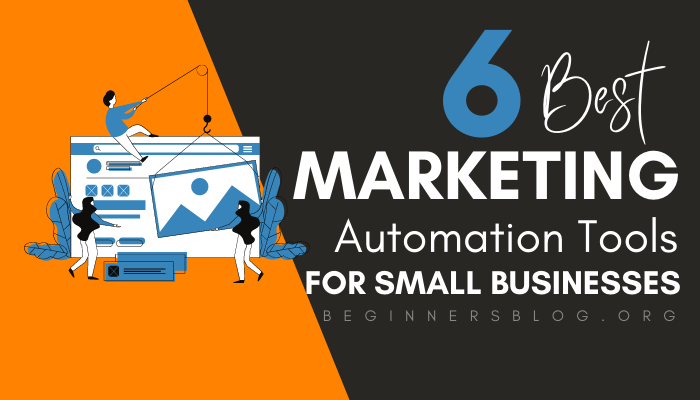Are you looking for the best marketing automation tools for small businesses? If yes, this post is for you!
Marketing automation has become a crucial part of any business’s marketing strategy, and it helps automate repetitive tasks and saves time and money. There are many different types of marketing automation software available today that can help your business grow.
This article will discuss some of the top marketing automation tools for small business owners.
Before we get into it, let me tell you what marketing automation is all about:
What Is Marketing Automation?
Marketing automation is an automated way to manage the entire sales funnel from lead generation to customer acquisition and retention. The primary objective of marketing automation is to automate as much of the process as possible to focus more on your core competencies.
The essential components of marketing automation include CRM (customer relationship management), email marketing, web analytics, social media, landing pages, etc. These components work together to create a complete marketing campaign.
1. Hubspot
Hubspot is a popular Inbound marketing software that allows you to create personalized emails to prospects based on their interests and behavior. You can also send out regular drip campaigns to keep your audience engaged.
Hubspot offers two versions of its product – Free and Pro. The free version includes basic functionality but doesn’t allow you to track or segment your contacts. On the other hand, the pro version comes with advanced features such as analytics, custom forms, user-defined tags, etc.
If you want to start generating leads without investing a lot of money, then Hubspot is a great option.
Top Features of Hubspot –
- Email Campaigns – You can use Hubspot to build highly targeted email campaigns by using data from your CRM system. You can even set up rules to automatically send emails when certain events happen.
- Landing Pages – Create beautiful landing pages within minutes. You can add videos, images, text, and links to your page. Use these pages to collect contact information, ask questions, and provide answers.
- Analytics – Track every click on your website through Hubspot’s powerful reporting tool. This feature lets you see which parts of your site effectively convert visitors into customers.
- A/B testing – Use A/B testing to compare the performance of different variations of your content. Create multiple versions of your landing pages and test them against each other.
- ABM (Account-Based Marketing) tools & Automation – You can target specific accounts with ABM tools instead of sending generic messages to everyone. You can also create dynamic campaigns that change depending on who opens your message.
- Multiple currencies -Hubspot enables you to sell products in multiple currencies, and you can choose between different currencies in your HubSpot account.
- Website Traffic Analytics – Monitor how many people visit your website and where they come from. You can also find out how long they stay on your site and what actions they take.
- Sandboxes – Experiment with new elements before implementing them on live sites. Sandboxes let you measure customer experience before deploying changes to production.
Hubspot Pricing
Hubspot offers a few basic marketing features for free but to get access to all the features; you need to upgrade to the paid Plan.
It has 3 pricing plans –
- Starter – $45/month
- Professional – $800/month
- Enterprise – $3200/month
2. Marketo
Marketo is an enterprise marketing platform designed to help small businesses grow. It helps companies manage their entire sales funnel, including lead generation, lead nurturing, engagement, conversion, and retention.
One of the most potent CRM tools (acquired by Adobe) lets you build highly targeted email campaigns. You can set goals for every campaign and measure ROI (Return on Investment).
It allows you to automate repetitive tasks like prospecting, qualifying leads, and following up with prospects.
Marketo also provides a feature that allows you to create lists of customers based on their demographics, location, purchase history, etc. It makes it easier for you to target specific audiences.
Top features of Marketo include:
- Lead Management – Lead management is one of the critical functions of any business. Marketo provides a comprehensive solution for managing all aspects of your lead lifecycle. You can quickly identify and nurture leads, convert them into customers, and retain them over time.
- Event & Webinar Marketing – You can use Marketo’s event and webinar marketing solutions to promote your events or webinars. You can send personalized invitations to attendees and track registrations with this feature.
- Marketing Calendar – Create a calendar of upcoming events and share it with your team to avoid missing anything important. You can also schedule meetings and assign tasks to team members.
- Email Marketing – Marketo includes several advanced email marketing features such as segmentation, autoresponders, and triggers. You can use these features to send personalized emails to your contacts based on their behavior.
- Campaign Reporting & Insights – Use Campaign reporting to analyze the performance of each campaign, so you know what changes need to be made to improve results. You can view detailed information about each contact, including their demographic data, purchase history, etc.
- Native CRM Integration – Integrate Marketo with other applications using its native integration options. You can connect Marketo with Salesforce, Microsoft, Google, Facebook, LinkedIn, etc.
Marketo Pricing
Not given! But you can Contact Marketo to know the pricing.
3. Sendinblue.com
SendinBlue is a cloud-based customer relationship management software used by thousands of marketers worldwide. The company was founded in 2010 and now has offices in San Francisco, New York City, London, Sydney, and Singapore.
The tool integrates seamlessly with various platforms, including Gmail, Outlook, Slack, Twitter, Facebook, Instagram, etc.
This CRM tool is best suited for those looking for a robust yet affordable solution. Sendinblue offers a free trial period before charging users monthly fees.
Sendinblue is a complete digital marketing toolkit for Businesses. It can help you with email marketing, SMS marketing, Chat integration on a website, and more.
Top features of SendinBlue:
- Email Marketing – With Sendinblue, you can create beautiful newsletters and drip-feed content for your subscribers. You can even integrate social media channels like Instagram and Twitter.
- SMS Marketing – You can send text messages to your customers’ phones with SMS marketing. You can also send bulk texts to multiple numbers at once.
- Chat Integration – With chat integration, you can add live chat support to your website. Your visitors will love chatting with you while browsing your site!
- Segmentation – Segment your users by age, gender, interests, location, etc. Then reach out to them individually via email or SMS.
- Reporting – Track the performance of every single message sent through Sendinblue. View reports on how many people opened your messages and which links were clicked.
- Marketing Automation – Automate your entire sales process with automated campaigns. Set up rules to trigger an email or SMS when certain actions happen. Create segments to target specific groups of users.
Sendinblue Pricing
If you are just getting started, you can use Sendinblue absolutely for Free. YES! It allows you to manage unlimited contacts. But it doesn’t let you send more than 300 emails a day.
However, if you want to scale up your business, you must pay $25 per month for the Lite plan.
You get access to essential features such as sending emails, SMS and creating landing pages.
In addition, you can upgrade to the Premium plan for $65/month. It gives you access to advanced features such as segmenting your audience, scheduling and integrating with third-party services.
You can go for the Enterprise plan if you need more powerful features. With this package, you can access everything the Lite and Premium plans to offer, plus additional integrations.
For instance, you can connect your account with Google Analytics, Hubspot, etc.
4. Customer.io
Customer.io is an automated marketing automation tool for small businesses. It’s designed to be easy to set up and use but still provides plenty of power and flexibility.
It’s an ideal choice for companies that don’t have much time to build and test their messaging flows. Customer.io makes it simple to build customer relationships, nurture leads, and turn visitors into paying customers.
Its customer segmentation engine lets you personalize communications based on user data, so you’re only reaching out to relevant audiences. And its visual workflow builder helps you quickly design complex workflows without writing code.
The platform integrates with popular apps including Slack, Trello, Mailchimp, Zendesk, and GitHub. You can also use Customer.io to collect customer feedback and measure campaign success.
Top Features of Customer.io
- Send Unlimited Emails
- Send SMS, Push, and Webhooks
- Track Unlimited Events and Attributes
- User Roles & Permissions
- Technical Support
Customer.io Pricing
Pricing starts from $150/month and goes up to $995 per month, including all features from the Basic Plan. Plus, a dedicated Customer Success Manager, deliverability control, and more.
5. Drip
Drip is an email automation tool that helps you automate drip campaigns, nurturing your leads over time.
With Drip, you can create personalized email sequences that automatically follow up with new subscribers. You can also send targeted messages at different stages in the buyer journey.
And you can even use Drip to create custom welcome series that help onboard new users.
With Drip, you can integrate with other platforms like Zapier, Salesforce, Stripe, etc.
So, whether you want to send emails about product updates, new blog posts, or stay on top of your mind, Drip has everything you need.
It offers a variety of ways to automate drip campaigns:
- Email – Drip will automatically create new email content in response to events like form submissions, page views, and social media interactions.
- Landing Pages – Drip includes landing page templates that allow you to create high-converting sales or lead-generation web forms easily.
- Scheduling – Create recurring email sequences at any frequency.
- Reporting – Track every aspect of your drip campaign using detailed reports.
- Custom Forms – Add custom fields to your forms and track responses using Drip’s reporting capabilities.
- Segmentation – Use Drip’s built-in segmentation rules to target specific groups of users.
- Email Sequences – Create automated email sequences triggered when specific actions occur. These sequences can be used to communicate new products, promotions, and other important information.
- Landing Page Templates – Use pre-built landing pages to create powerful conversion funnels for your business.
- Clickfunnels integration with Drip makes creating high-converting funnels.
Drip Pricing
- – $19/month (Email)
- – $22/month (Email + SMS)
6. ActiveCampaign
With 870+ integrations, ActiveCampaign is one of the most widely used marketing automation tools. It allows you to build highly customized CRM software by combining marketing automation and customer relationship management.
ActiveCampaign comes with a drag-and-drop interface that lets you build beautiful email templates and customize workflows.
You can also add third-party services such as Facebook Ads, Google Analytics, and HubSpot into your workflow.
Top ActiveCampaign Features –
- Marketing Automation
- Email Marketing
- Unlimited Email Sending
- Drag & Drop Email Builder
- 125+ Email Templates
- Send Newsletters
- Subscription Forms
- Segmentation
- Campaign and Automation Reporting
ActiveCampaign Pricing
- – Free Trial
- – $9/month (Lite Plan)
- – $49/month (Plus Plan)
- – $149/month (Professional Plan)
- – $258/month (Entreprise Plan)
Conclusion
Marketing involves a lot more than sending out promotional emails, and it’s bigger than that. Your goal should be to nurture relationships with customers and prospects so they become loyal fans of your brand.
It means building trust through consistent messaging, providing helpful content, responding to inquiries, and keeping them up to date on what’s happening in your industry.
And obviously, you can’t do this all manually, which is why marketing automation tools have become indispensable.
The best marketing automation tools help you manage these tasks while freeing up time to focus on growing your business.
And in this guide, I’ve covered some of the best marketing automation tools available today. I hope these guides help you find a tool that works well for your needs.
If you have any questions about these tools, please comment below!
Also, please share it on Facebook, Twitter, LinkedIn, and Pinterest.






